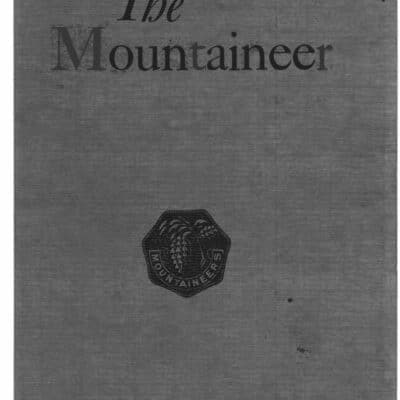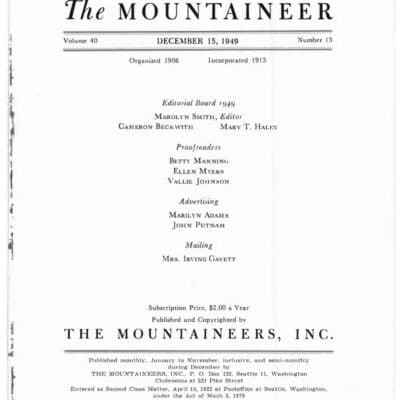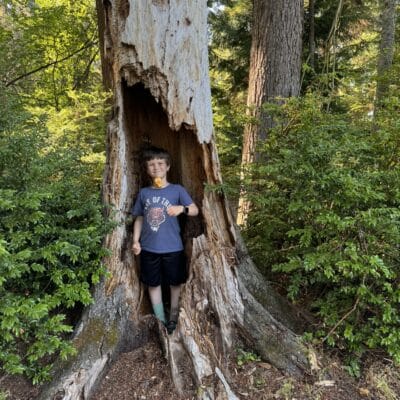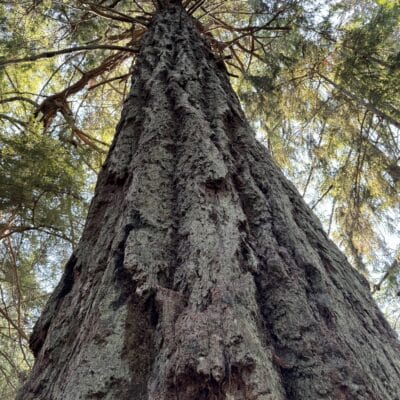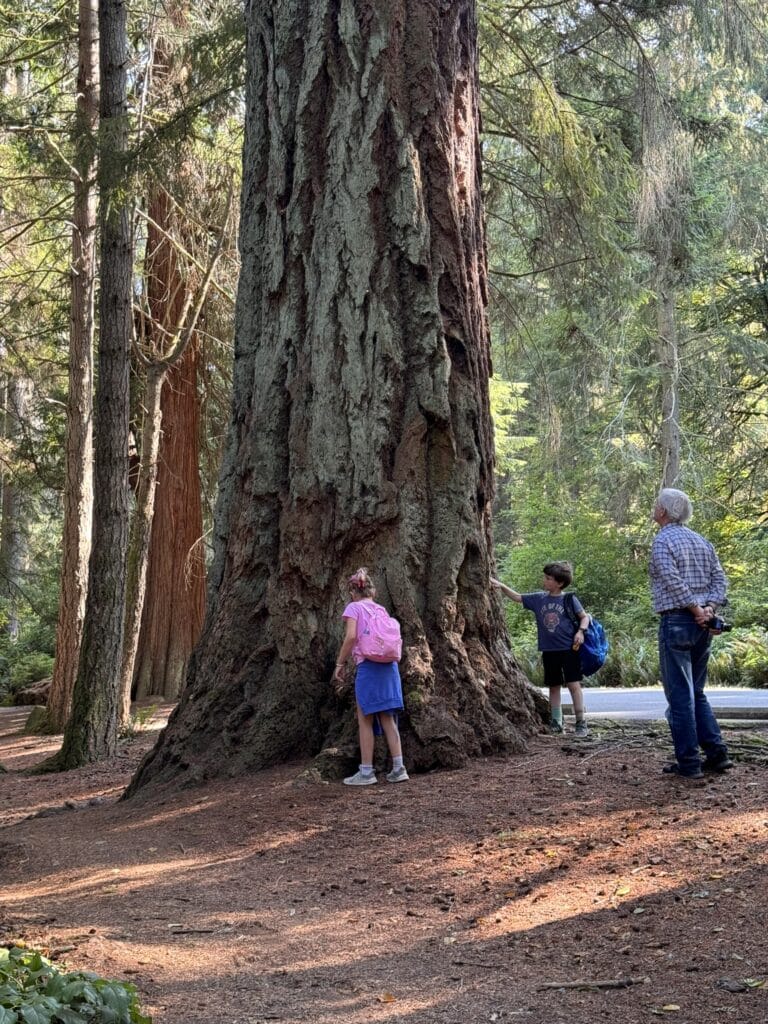Arts & Entertainment Community
Two in Tow & On the Go | Tacoma’s Mountaineer Tree is a giant of the forest
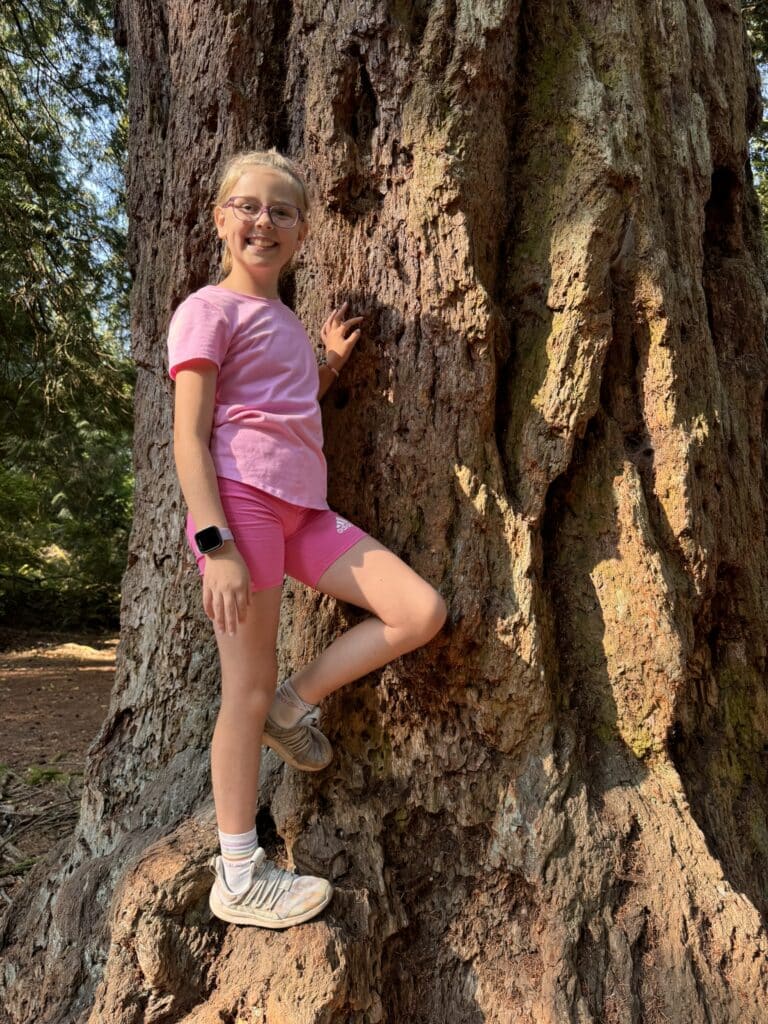
We’re actually here to say hello to a tree. A very big tree. A mighty conifer, if you will. One that’s been standing tall since before Washington was a state — or even a territory. Locals know it as the Mountaineer Tree, an almost 220-foot-tall living legend that’s called Tacoma home since the 1500s. And it lives just over the bridge at Point Defiance Park, one of the state’s last remaining original old-growth forests.
The Mountaineer Tree is an elder giant, one of the area’s vanishingly few survivors of the centuries-old forests that once blanketed the region before loggers arrived.
Located in the park’s upper peninsula, those seeking the Mountaineer Tree can find it just off the paved Outer Loop of Five Mile Drive, which remains closed to vehicles. The no-car sitch makes this adventure especially family-friendly since the loop makes for a flat, paved route for pedestrians, strollers and wheelchairs alike.
Destinations like the Mountaineer Tree are part of the thrill of exploring Point Defiance. You never know what you’ll stumble on next — a bald eagle sighting, a tilted madrona grove, or a giant tree stretching toward the clouds.
Look for a sign
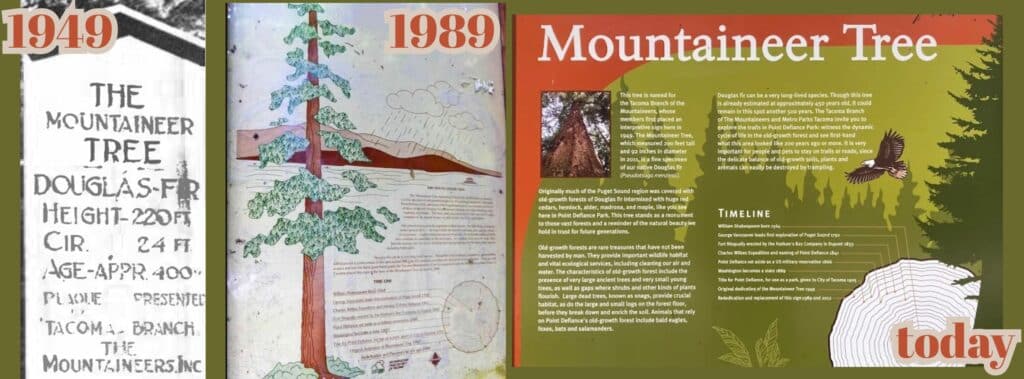
Mountaineer Tree signage through the years. (Sources from left: “The Mountaineer” annual, Dec. 15, 1949; therxfortravel.com blogger; Google).
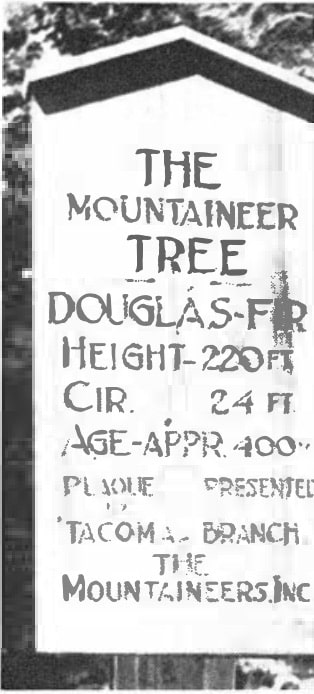
The tree is named after The Mountaineers, a regional hiking club still in existence today. The Mountaineers club began in 1906 in Seattle with a group of folks who set out to explore the peaks and waterways of the Pacific Northwest. Six years later, a Tacoma auxiliary branch formed. In March 1912, the “Auxiliary to the Mountaineers” was organized in Tacoma and became active in hosting multi-day excursions and walks. The Tacoma group formally incorporated in 1913. Each winter, members produced an annual publication featuring articles, poems, and photos detailing the club’s events and activities from the preceding months, which was shared between the Tacoma and Seattle branches.
Three of the club’s signs have repped the Mountaineer Tree in the last 75 years— the original in 1949, its replacement in 1989 and the newest version in 2012, respectively. Together, the markers have been not only as a source of information for visitors, but cool photo-ops through the generations.
In all, the signage tells the Mountaineer Tree’s enduring story:
- It’s a Douglas fir (Pseudotsuga menziesii), a species known within the Washington State Department of Natural Resources as the overachiever of the pine family. They say Douglas firs are, in general, the biggest and tallest of their class and can grow just about anywhere in western Washington, from windy mountain ridges to salty sea-level shores (just not in the super soggy spots).
- Its massive trunk is more than huggable, spanning nearly 8 feet in diameter (or a circumference of about 24 feet). Some Douglas firs can shoot up to 300 feet and live for over 1,000 years. This one was measured at 220 feet in 1949.
- Also in 1949, the tree was estimated to be about 400 years old.
FUN FACT: The Mountaineer Tree is highlighted in Tacoma’s 2023 Heritage Tree Program database for “trees of exemplary size, age, and/or significance.” You can see all the Heritage Trees on this interactive map.
1949 Sign
The first sign in 1949 included several measurements hand-carved into a wooden board by Mountaineers Club member Ruth Corbit. The marker, as the club called it back then, stood for 40 years and appeared in many visitors’ scrapbooks. In 2019, Point Defiance Park’s Facebook page shared one users’ vintage snapshot with the original sign, likely taken in the 1960s, 70s or 80s:
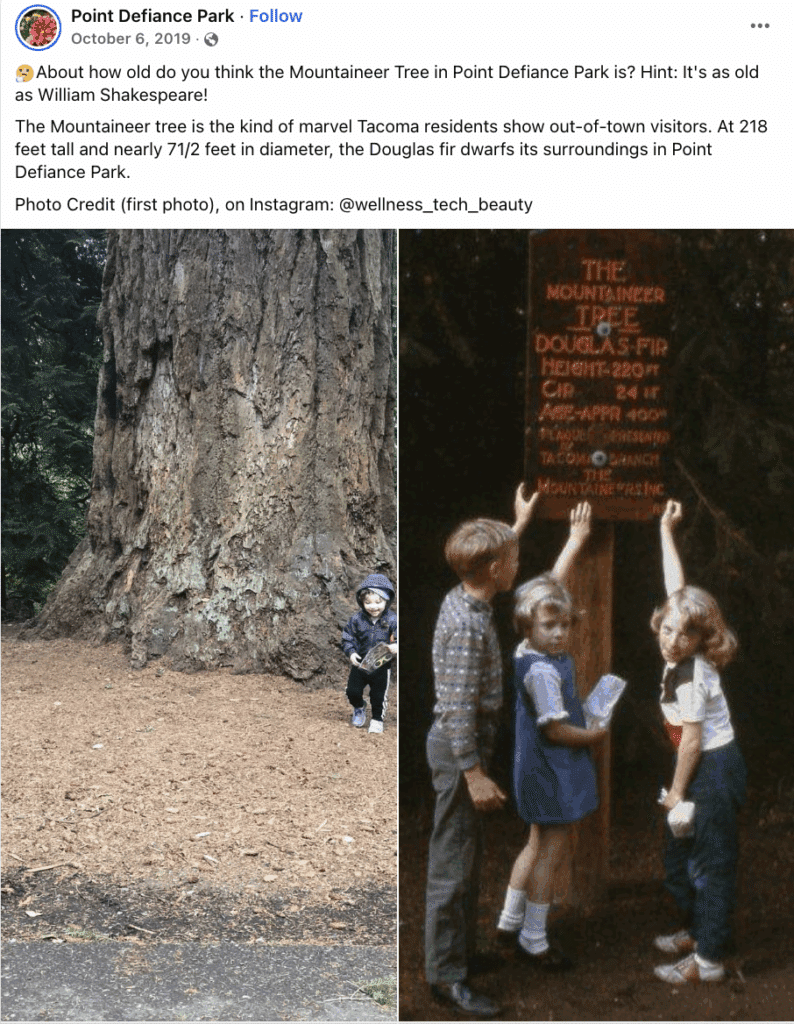
Source: PenMet Parks, Facebook
1989 sign rededication ceremony
The 1940s sign remained up until 1989 when a replacement sign took the place of its successor beneath the canopy of the Mountaineer Tree during an Arbor Day celebration. The day’s festivities also included nature walks and the planting of a baby Douglas Fir in the park. The visuals on the new version offered a timeline through the lens of the tree’s growth rings spanning its 400-plus-year history, highlighting what was happening in society and pop culture during each corresponding era. Of all the ways to measure its grandeur, the Mountaineer Tree’s age alone is enough to give anyone pause. This fact is further emphasized by Metro Parks Tacoma—the public recreation agency that manages Point Defiance—whose staff often share on Facebook that the tree is as old as William Shakespeare, born in 1564, a detail noted at the center of the tree-ring diagram:
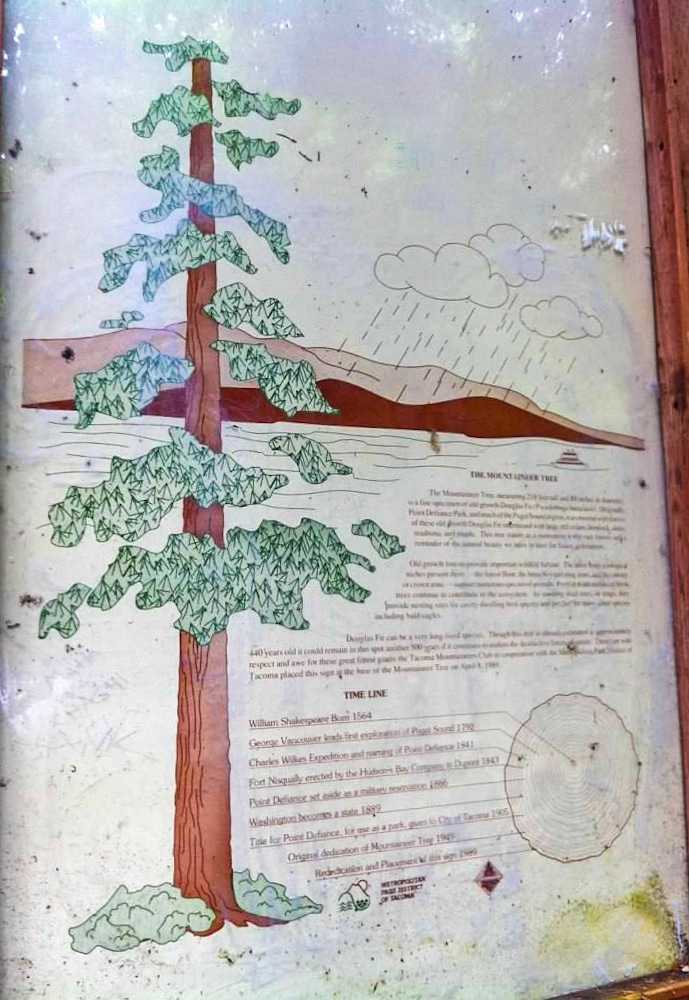
1989 Sign. Source: www.therxfortravel.com blog.
2012 sign
A third version of the sign, the one that’s up today, came in 2012. The year before, the tree was re-measured, so the 2012 sign stats were updated to reflect changes to the tree (or to modern measurement-taking) since 1949.
Part of the new sign reads:
“This tree is named for the Tacoma Branch of the Mountaineers, whose members first placed an interpretive sign here in 1949. The Mountaineer Tree, which measured 200 feet tall and 92 inches in diameter in 2011, is a fine specimen of our native Douglas fir.”
The current signage also keeps the graphic design idea of the 1989 tree ring timeline. Its overall look was modernized and the final design sported earth-tone color palette:
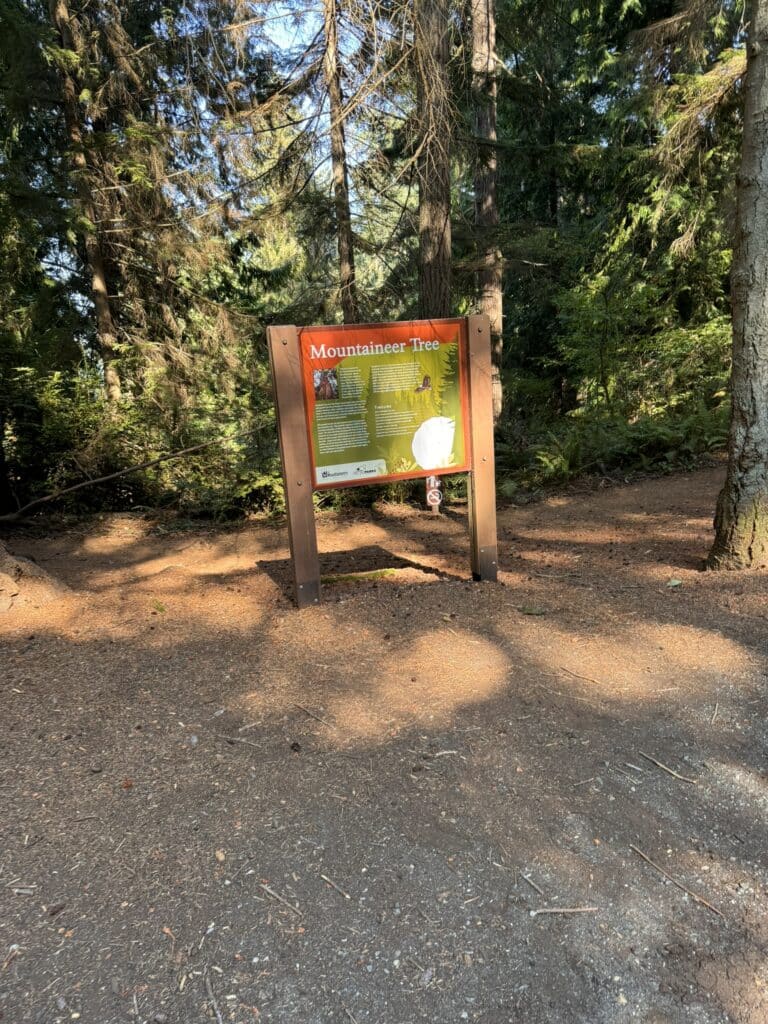
Today’s sign, installed in 2012.
The “discovery”
Back in 1949, the Tacoma Mountaineers weren’t just celebrating the remarkable fir with signage. They were sharing a piece of the wild that matched their own spirit of adventure, conservation, and respect for the natural world. The Mountaineer Tree project, as it was called, was noted as a standout achievement in the group’s 1949 year-end annual. In an article highlighting the Tacoma chapter’s notable activities that year, it was revealed that the project wasn’t just a sign — it was the hiking club that “uncovered” the tree from the previously untouched forest depths.
The passage explains the Mountaineer Tree was “heretofore not visible to the public” until it caught the attention of club member Carl Heaton.
Here’s an excerpt:

The Mountaineer newsletter, Dec. 15, 1949. Source: mountaineers.org
Here’s above excerpt transcribed:
“On the Five Mile Drive of Point Defiance Park there stands a Douglas Fir Tree is about 400 years old, 24 feet in circumference and 220 feet tall! heretofore not visible to the public. Due to the efforts of Carl Heaton it now draws hundreds of visitors and bears a handsomely hand carved plaque done by our own Ruth Corbit. Carl Heaton is a member of Tacoma’s newest committee, born this year, devoted to conservation, and ably chairmaned by Leo Gallagher.”
1948 – Cutting the path
Further, a surprising “discovery” of my own during research for this article revealed that the club’s 1948 annual—published the year before the sign was installed—contained additional details about Heaton’s brush-clearing endeavor. It shows that the Mountaineers didn’t simply walk up to the tree in an open clearing and plop a sign down to mark its size. One of the members actually “uncovered” the conifer. Heaton, mentioned above, cut through Point Defiance Park’s largely untouched central forest area’s massive tangle of brush and vegetation leading up to the tree, physically clearing a path to it and unveiling its grandeur for all to see. The 1948 annual goes on to say Heaton’s work revealed “an especially healthy specimen 30 feet off the road near Point Gulch was chosen ‘The Mountaineer Tree’ and was so dedicated with appropriate formalities.”
Here’s the 1948 excerpt:

“The Mountaineer” annual publication from 1948. Source: mountaineers.org
And its transcription:
“During the summer gay evenings were spent around the campfire at the homes of the Benjamins, the Corbets and the Goodmans. In September, G. E. Heaten, aroused to the desirability of new trails in Point Defiance Park, lead a group of 23 into the little known central arca, on paths he had previously chopped out of the rough terrain. We measured 23 of the 33 big Douglas fir trees shown on Mr. Heaten’s map and found ten were over 23 feet in circumference, and the largest was 28 feet. An especially healthy specimen 30 feet off the road near Point Gulch was chosen “The Mountaineer Tree” and was so dedicated with appropriate formalities.”
Carl Heaton
I’m curious whether “Carl Heaton” and “G.E. Heaten” are the same person whose name was misspelled in two places or just two similarly-named guys. My guess is the latter, because:
- in 1949, the club’s annual credits the brush-clearing discovery to a “Carl Heaton” by name;
- in a June 12, 1955 article of the Tacoma News Tribune, “Carl Heaton” made headlines again for his efforts in Point Defiance Park to open the “Big Tree Trail,” with the Mountaineer Tree being one of the points of interest.
- When he died at age 87, Carl’s obit published in the Tacoma News Tribune on Nov. 8, 1969 says his middle name is Edwin, which would make him “C.E. Heaton.”
During the trail’s dedication ceremony, the newspaper reported that Heaton led a public walk through his new trail, which led to “a grove of 40 massive trees, each over 22 feet in circumference and at least 7 feet in diameter. Eagle Scouts from Troop 27, led by John Simac and Heaton, helped blaze the trail and planted hundreds of new Douglas firs. The well-known Mountaineer Tree is one of the highlighted stops along the route. No trees were cut during the trail’s creation, which offers a scenic 20-minute loop including a bridge over a gulch.”
And with that new information, I now present to you an assignment:
Reader Homework: Are the Big Tree Trail and its “bridge over a gulch” still at Point Defiance? And, where is Point Gulch? (Bonus points if someone can find any or all of those locations by name on a map and send it to me at [email protected]).
Our experience in 2024
Except … I now pose a question: Was this massive 1989 Tallest Tree Ever as impressive as the Mountaineer Tree in 2024? We think not, Mr. Spadoni. Because the hiking club’s tree is still standing today.
Getting there
The Mountaineer Tree remains one of the most accessible giants in the park. Nestled right on the edge of the park’s paved and car-free Five Mile Drive, which has since closed to vehicles due to cliff erosion, the scenic loop is still walkable, making the tree an easy stop for families and nature lovers alike.
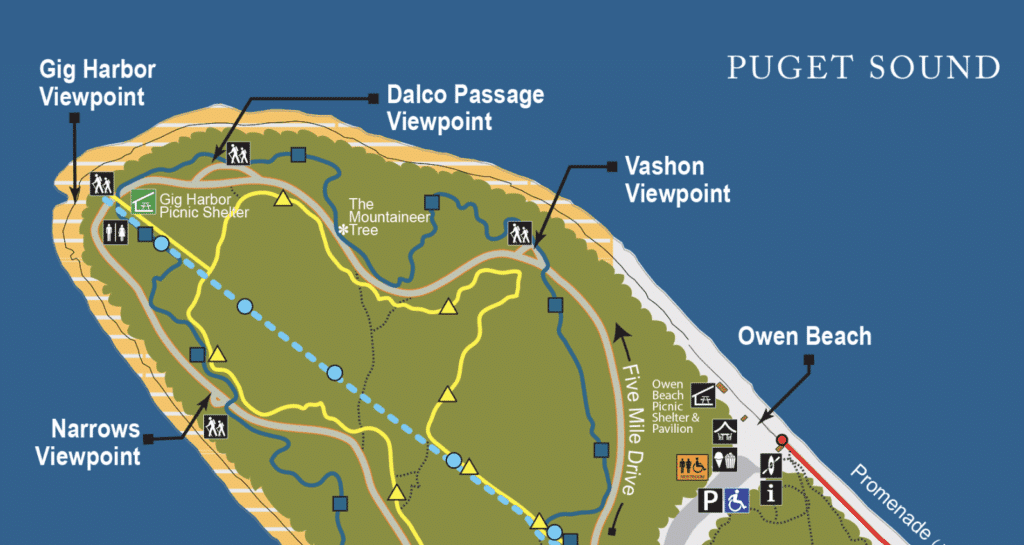
See ya out there!

Tonya Strickland is a Gig Harbor mom-of-two and longtime journalist. Now in the travel and family niche, her blog, Two in Tow & On the Go, was named among the 10 Seattle-Area Instagram Accounts to Follow by ParentMap magazine. Tonya and her husband Bowen moved to Gig Harbor from California with their two kids, Clara (11) and Wyatt (9) in 2021. Find them on Facebook for all the kid-friendly places in and around town.

